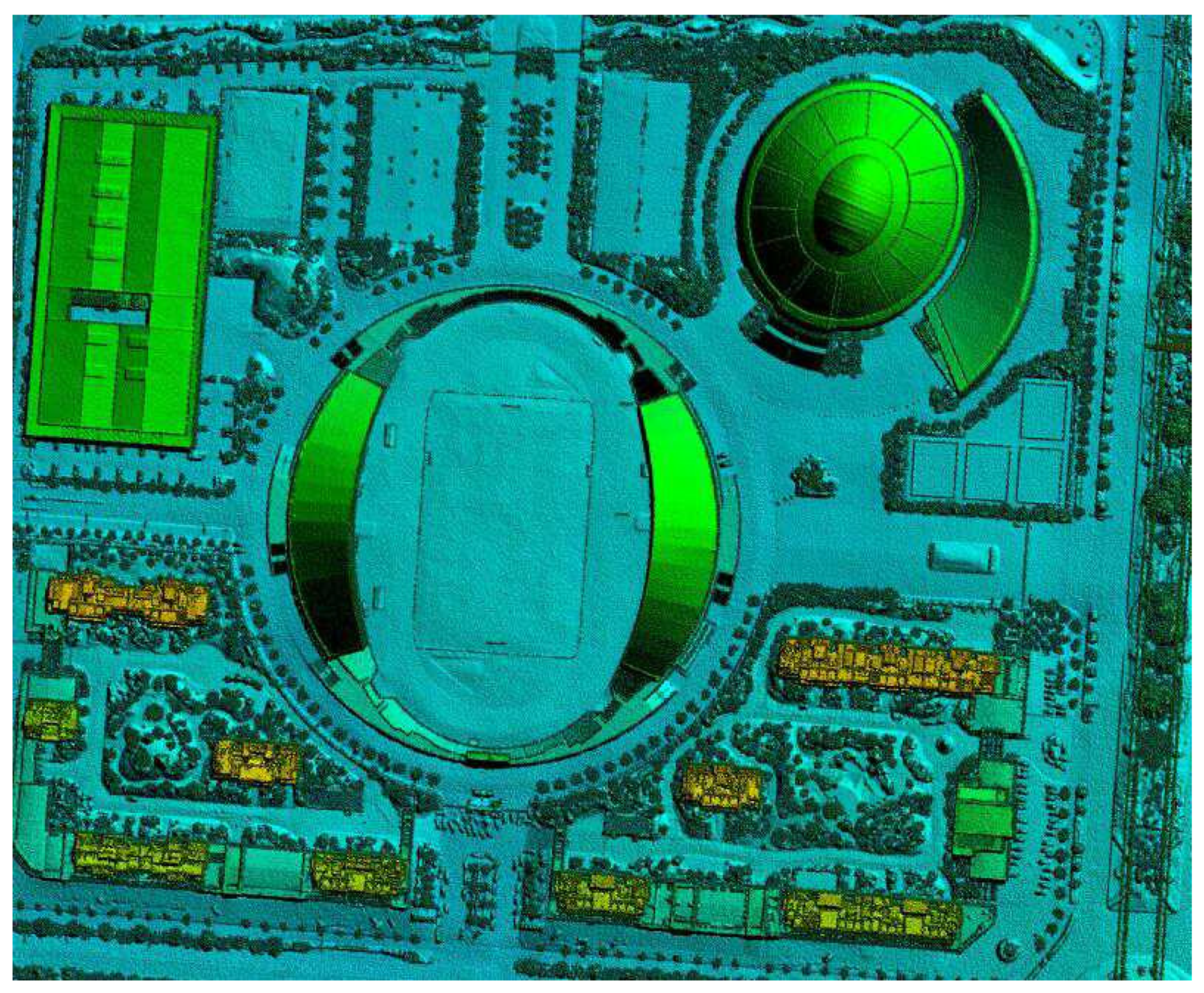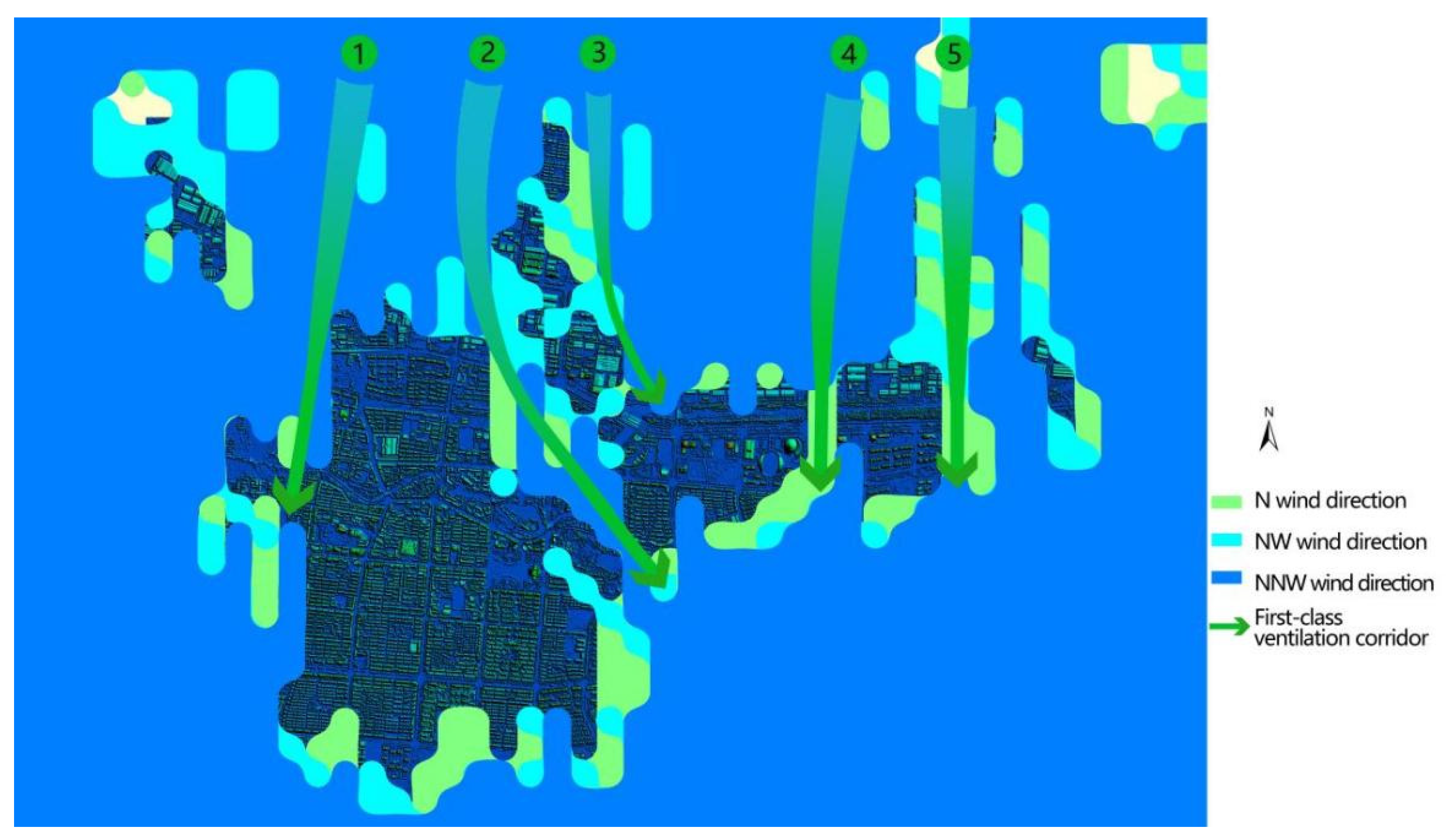Intelligent Mining of Urban Ventilation Corridors Based on High-Precision Oblique Photographic Images
Abstract
:1. Introduction
2. City Correlation Analysis and Frontal Area Calculation
2.1. Oblique Photography and Urban Digital Data Acquisition
2.2. Wind Rose Chart and Statistics of the City’s Dominant Directions
2.3. City Ventilation and Frontal Area Density Calculation
3. Definition of Urban Ventilation Corridor
- (1)
- VC length > 500 m (preferably 1000 m and above);
- (2)
- VC width ≮ 30 m (building interval, preferably 50 m and above). Among them, the suitable width of an urban air duct was >100 m and a block-scale ventilation corridor VC width ≮ 30 m and a VC width ≯ 100 m;
- (3)
- θ < 45° (where θ is the dominant wind direction of the VC direction), when the urban air duct was parallel to the dominant wind direction, the ventilation efficiency of the air duct was the best, and θ < 30° was more conducive to improvements in the overall wind environment.
- FAD ≤ 0.35 means natural wind enters smoothly;
- 0.35 < FAD ≤ 0.45 means that the natural wind does not enter smoothly;
- 0.45 < FAD ≤ 0.6 means that the natural wind is obstructed;
- FAD > 0.6 means that there is a big obstacle for natural wind to enter.
4. Intelligent Mining of Urban Ventilation Corridors Based on Templates
4.1. Template Calculation
4.2. Template Design
4.3. Automatic Mining Process and Algorithm of the Urban Ventilation Corridor
- (a)
- When excavating the corridor, the length of corridor should first be set. This paper used a conclusion from a previous study that determined the length of a corridor is greater than 500 m, and the length of a corridor generally takes 1000 m.
- (b)
- We can choose a corridor width of one of the wind directions and use the template of the wind direction to match the frontal area density map. Then, the corridor of the alpah1 wind direction can be obtained. Finally, we can calculate the total area of the corridor (that is, the width of the corridor multiplied by the length of the corridor).
- (c)
- We can complete the template matching of the alpha2 and alpha3 wind directions and find the best ventilation corridor, that is, the total area of the corridor reaches the maximum.
- (d)
- Repeat step (c), complete the template matching of the alpha2 and alpha3 wind directions and determine the best ventilation corridor, that is, the total area of the corridor reaches the maximum. The specific process is shown in Figure 13.
5. Experiment and Result Analysis
5.1. Experimental Settings
5.2. Calculation of the Maximum Effective Width of a Ventilation Corridor
5.3. Results of Ventilation Corridors
6. Conclusions
Author Contributions
Funding
Institutional Review Board Statement
Informed Consent Statement
Data Availability Statement
Conflicts of Interest
References
- Yu, C.L. A Review of Research on Urbanization in China—An Analysis Based on Journals Included in China Knowledge Network (1979–2017). Rural. Econ. Sci.-Technol. 2020, 17, 308–311. [Google Scholar]
- Ren, C.; Yang, R.; Cheng, C.; Xing, P.; Fang, X.; Zhang, S.; Wang, H.; Shi, Y.; Zhang, X.; Kwok, Y.; et al. Creating breathing cities by adopting urban ventilation assessment and wind corridor plan—The implementation in Chinese cities. J. Wind. Eng. Ind. Aerodyn. 2018, 182, 170–188. [Google Scholar] [CrossRef]
- Huang, C.; Wei, Z.C.; Cao, J. Construction and Regulation of Urban Ventilation Corridor System: A Case Study of Hefei. Shanghai Urban Plan. Rev. 2020, 4, 120–125. [Google Scholar]
- Hsieh, C.-M.; Huang, H.-C. Mitigating urban heat islands: A method to identify potential wind corridor for cooling and ventilation. Comput. Environ. Urban Syst. 2016, 57, 130–143. [Google Scholar] [CrossRef]
- Ramponi, R.; Blocken, B.; Laura, B.; Janssena, W.D. CFD simulation of outdoor ventilation of generic urban configurations with different urban densities and equal and unequal street widths. Build. Environ. 2015, 92, 152–166. [Google Scholar] [CrossRef] [Green Version]
- Wang, Q.; Sandberg, M.; Lin, Y.; Yin, S.; Hang, J. Impacts of Urban Layouts and Open Space on Urban Ventilation Evaluated by Concentration Decay Method. Atmosphere 2017, 8, 169. [Google Scholar] [CrossRef] [Green Version]
- Liu, H.N.; He, X.D.; Miao, S.G.; Yu, B.; Wei, L.; Wang, X. Study on meteorological effects of ventilation corridors in Hangzhou based on high-resolution numerical simulation. Clim. Environ. Res. 2019, 24, 22–36. [Google Scholar]
- Dang, B.; Fang, X.Y.; Cai, J.Z. Research and application of urban ventilation corridor planning technology—Taking Shaoxing Yuecheng District as an example. In Proceedings of the 2017 Annual Conference of the Chinese Society of Environmental Science on Science and Technology (Volume III), Xiamen, China, 17 October 2017. [Google Scholar]
- Ai, J.Y. Application of Aerial Photogrammetry Technology in the Topographic Survey Project of Fanjia Oh. North China Nat. Resour. 2020, 5, 99–101. [Google Scholar]
- Wang, T.; Liu, Y.; Zheng, X.; Dai, H.; Jia, W.; Xie, M. Edge-Based Communication Optimization for Distributed Federated Learning. IEEE Trans. Netw. Sci. Eng. 2021. [Google Scholar] [CrossRef]
- Wang, T.; Zhang, Y.; Xiong, N.; Wan, S.; Shen, S.; Huang, S. An Effective Edge-Intelligent Service Placement Technology for 5G-and-beyond Industrial IoT. IEEE Trans. Ind. Inform. 2021. [Google Scholar] [CrossRef]
- Zeng, S.P. Urban Wind Environment Optimization and CFD Analysis Based on “Source-Flow-Sink” Theory: Tianjin City as an Example; Tianjin University: Tianjin, China, 2016. [Google Scholar]
- Wang, X.X.; Li, Y.G. Predicting urban heat island circulation using CFD. Build. Environ. 2016, 99, 82–97. [Google Scholar] [CrossRef]
- Hang, J.; Luo, Z.; Wang, X.; He, L.; Wang, B.; Zhu, W. The influence of street layouts and viaduct settings on daily CO exposure and intake fraction in idealized urban canyons. Environ. Pollut. 2017, 220, 72–86. [Google Scholar] [CrossRef] [PubMed]
- Hu, J.D.; Xie, F.; Wang, Y. Simulation study of wind environment and landscape design strategy exploration of Hangzhou Qiantang River block based on CFD digital technology. Urban Constr. Theory Res. 2020, 17, 122–123. [Google Scholar]
- Yuan, Z. The Research of Multi-Scale Urban Ventilation Channel Construction Method and Planning Strategy: A Case Study of Xian; Xibei University: Shanxi, China, 2017. [Google Scholar]
- Zhang, Y.L.; Li, X. Study on Urban Ventilation Channels Planning Based on Optimization of the Spatial Layout in Urban Green Space: A Case Study of Jinzhong. Urban Stud. 2017, 24, 35–41. [Google Scholar]
- Li, X.H. Research on DSM-based height extraction method for urban buildings. North China Nat. Resour. 2020, 5, 97–98. [Google Scholar]
- Chen, C.H.; Jiang, Y.Q.; He, H.J. Design of a new wind rose and its application to wind field data from ocean stations. Ocean. Dev. Manag. 2015, 6, 71–74. [Google Scholar]
- Yin, J.; Zhan, Q.M. Urban Street Wind Path Research Based on GIS and CFD—A case study of Wuhan. Chin. Landsc. Archit. 2019, 6, 84–88. [Google Scholar]
- Zeng, S.Q.; Qin, Y.; Chen, Y.H. Identification and impact analysis of ventilation corridors in Shanghai. J. Donghua Univ. (Nat. Sci. Ed.) 2018, 6, 954–958. [Google Scholar]
- Tian, K.Q.; Jia, Y.Y.; Liu, Q.H. Experimental Research on Width of Urban Street’s Effect on Wind. J. Shijiazhuang Tiedao Univ. (Nat. Sci. Ed.) 2019, 4, 16–21. [Google Scholar]
- Shen, J.; Qiu, X.; He, Y.; Yan, Z.; Li, M. Study on Comparison of Vector/Raster Calculation Model of Frontal Area Density of Urban Buildings. J. Geo-Inf. Sci. 2017, 19, 1433–1441. [Google Scholar]





















| Corridor Width = 30 m | Corridor Width = 50 m | Corridor Width = 70 m | Corridor Width = 100 m | Corridor Width = 120 m | |
|---|---|---|---|---|---|
| Corridor length = 500 m | 0.4548 | 0.6539 | 0.7212 | 0.7170 | 0.7271 |
| Corridor length = 1000 m | 0.3504 | 0.5282 | 0.6178 | 0.6269 | 0.6157 |
| Corridor length = 1500 m | 0.2879 | 0.4548 | 0.5475 | 0.5521 | 0.5290 |
| Corridor length = 2000 m | 0.2433 | 0.3963 | 0.4729 | 0.4689 | 0.4583 |
| Corridor Width = 30 m | Corridor Width = 50 m | Corridor Width = 70 m | Corridor Width = 100 m | Corridor Width = 120 m | |
|---|---|---|---|---|---|
| Corridor length = 500 m | 0.4856 | 0.6922 | 0.7610 | 0.7903 | 0.7363 |
| Corridor length = 1000 m | 0.4025 | 0.5681 | 0.6424 | 0.6794 | 0.6038 |
| Corridor length = 1500 m | 0.3322 | 0.5033 | 0.5837 | 0.5977 | 0.5532 |
| Corridor length = 2000 m | 0.2737 | 0.4275 | 0.5060 | 0.5231 | 0.4608 |
| Corridor length = 2500 m | 0.2237 | 0.3809 | 0.4618 | 0.4901 | 0.4219 |
| Corridor Width = 30 m | Corridor Width = 50 m | Corridor Width = 70 m | Corridor Width = 100 m | Corridor Width = 120 m | |
|---|---|---|---|---|---|
| Corridor length = 500 m | 0.4584 | 0.6609 | 0.7594 | 0.7513 | 0.6959 |
| Corridor length = 1000 m | 0.3516 | 0.5451 | 0.6471 | 0.6326 | 0.5967 |
| Corridor length = 1500 m | 0.2892 | 0.4678 | 0.5805 | 0.5687 | 0.5214 |
| Corridor length = 2000 m | 0.2493 | 0.4110 | 0.5115 | 0.4955 | 0.4620 |
| Corridor Width = 30 m | Corridor Width = 50 m | Corridor Width = 70 m | Corridor Width = 100 m | Corridor Width = 150 m | |
|---|---|---|---|---|---|
| Wind direction = −67.5° | 0.5853 | 0.7015 | 0.7727 | 0.7701 | 0.7295 |
| Wind direction = −45° | 0.6632 | 0.7569 | 0.8289 | 0.7900 | 0.7879 |
| Wind direction = −90° | 0.3516 | 0.5451 | 0.6326 | 0.5967 | 0.5920 |
Publisher’s Note: MDPI stays neutral with regard to jurisdictional claims in published maps and institutional affiliations. |
© 2021 by the authors. Licensee MDPI, Basel, Switzerland. This article is an open access article distributed under the terms and conditions of the Creative Commons Attribution (CC BY) license (https://creativecommons.org/licenses/by/4.0/).
Share and Cite
Chen, C.; Ye, S.; Bai, Z.; Wang, J.; Zhang, Z.; Ablameyko, S. Intelligent Mining of Urban Ventilation Corridors Based on High-Precision Oblique Photographic Images. Sensors 2021, 21, 7537. https://doi.org/10.3390/s21227537
Chen C, Ye S, Bai Z, Wang J, Zhang Z, Ablameyko S. Intelligent Mining of Urban Ventilation Corridors Based on High-Precision Oblique Photographic Images. Sensors. 2021; 21(22):7537. https://doi.org/10.3390/s21227537
Chicago/Turabian StyleChen, Chaoxiang, Shiping Ye, Zhican Bai, Juan Wang, Zongbiao Zhang, and Sergey Ablameyko. 2021. "Intelligent Mining of Urban Ventilation Corridors Based on High-Precision Oblique Photographic Images" Sensors 21, no. 22: 7537. https://doi.org/10.3390/s21227537
APA StyleChen, C., Ye, S., Bai, Z., Wang, J., Zhang, Z., & Ablameyko, S. (2021). Intelligent Mining of Urban Ventilation Corridors Based on High-Precision Oblique Photographic Images. Sensors, 21(22), 7537. https://doi.org/10.3390/s21227537





